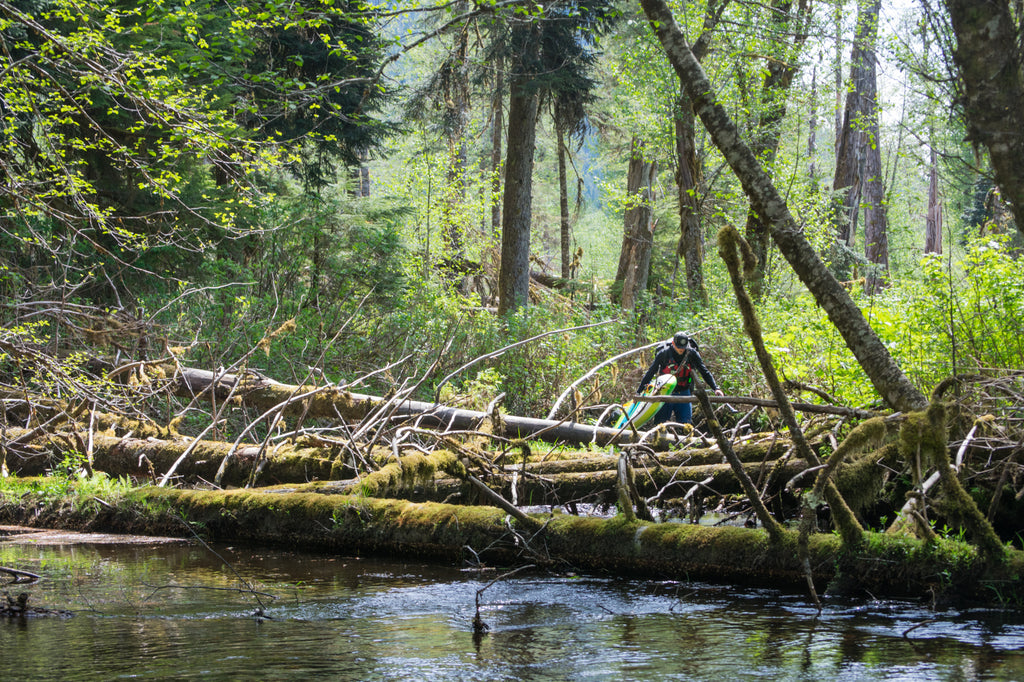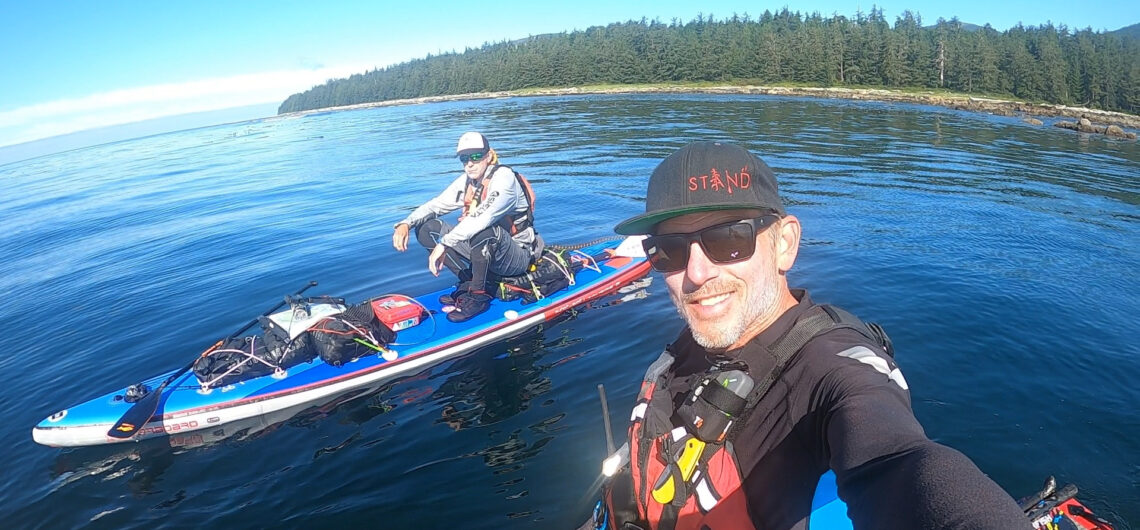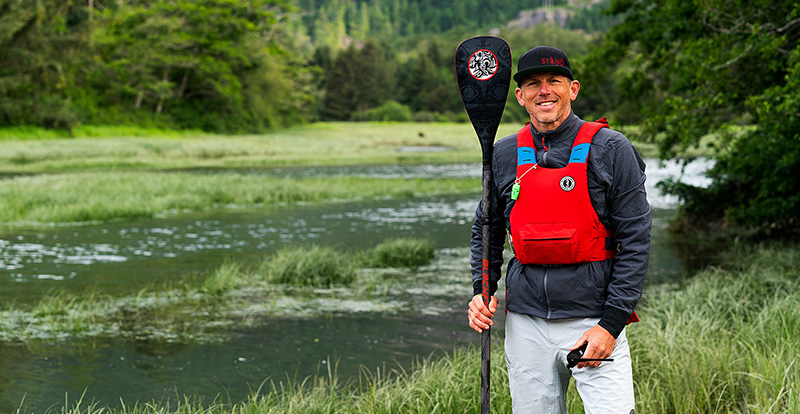When it comes to knowing how to pack for a SUP trip—no matter how many days you’re heading out for—Norm Hann and Bruce Kirkby are the go-to pros to learn how to prep and pack for any standup paddling trip.
They met in 2012 and have been heading out for adventures and expeditions together, and with groups, ever since. Why the passion for standup paddling expeditions? Paddling trips are an incredible way to experience the coast and shorelines, exposing you to beaches and corners of marine environments that can’t be accessed by boats or roads. Taking the time to learn how to plan and pack for longer SUP adventures opens up a whole world of new ways to enjoy the water – something both Norm and Bruce have experienced themselves, and loved sharing with their expedition guests.
Whether you’re going out on a day trip, testing the waters of an overnight and taking on your first multi-day, get ready to get out there with confidence and courage – and some well-packed gear.

What to pack for a SUP trip
The foundational strategy for packing for a SUP trip is similar to packing for a backpacking trip, with a special focus on clothes (you’ll learn why).
Both Norm and Bruce coach their expedition clients to work to pack as little as possible, considering weight, without forgetting key essentials for their safety, comfort, and nourishment.
Here’s what they make sure they bring, and have guests pack too:
Paddling Gear: Touring board, fin, adjustable paddle, PFD with whistle, tow line, throw bag, spare paddle and a spare fin.
Safety Gear: First aid kit, Charts/Tides, VHF Marine weather radio (ocean) or Satellite Phone (rivers/lakes) and or Satellite Communicator like a Delorme In Reach or Spot.
Camp Setup: 2-3 person tent, sleeping bag, sleeping pad, compressible pillow, headlamp, stove and fuel, food and small essentials for cooking and eating (bowl, spork, insulated mug, small pot, knife, etc.) based on your meal plan.

Clothing: For a good clothing system think about keeping one complete set of dry camp clothes (socks, pants, shirt, midlayer, outerlayer, something to keep your head warm, camp shoes), one complete set of paddling clothes (weather + seasonally thoughtful clothes for sun protection, immersion and warmth, that make it easy to paddle and won’t weigh you down if you go in).
Food: oatmeal, coffee, tea, dehydrated meals, and lightweight snacks that are nutrient and energy dense, fresh water AND a backup plan for H2O. Big fan of fresh food? Read on…there’s a method to the dehydrated food ‘madness’ in the section below.

How to choose your SUP touring gear
When choosing gear for SUP touring or trips, it’s easy to go down the rabbit hole of ‘most lightweight everything’. And, making thoughtful choices about the gear you’re bringing means considering weight AND usability, functionality, warmth – and more. Here are some products Norm and Bruce always pack, and brands they love and trust.
- Instead of wetsuits, on cooler spring/fall days on when on expedition they’re a big fan of stretch neoprene pants and tops; their favorite gear to paddle in are the Vaikobi V Cold Pants and Long Sleeve Base Layer top offering lots of mobility, breathability and some protection in the event of a swim. They also pair the waterproof Mustang Survival Callan short over top the pants.
- Saving weight on the camp stove makes sense – and the MSR WhisperLight Stove does the trick.
- Packing a North Water Sealink Tow Line is nice in case you need to tow your partner or a board.
- Emergency tape can get you out of a bind when you need it most. VSSL carries an incredible emergency tape that’s held holes in a hardboard for an entire trip. You can find it in their Fix It supply pack. *NOTE: gentle reminder – inflatable boards are hard to fix in the field – one of the downfalls of an inflatable on an extended trip.
- There’s not enough attention paid to the paddle – even through it’s what is in your hands all day long. Norm and Bruce use adjustable Blackfish Paddles; they’re lightweight, durable with a smaller blade face – which becomes important as you start moving a fully loaded touring board in a headwind. Pro tip: make sure your spare paddle is the same quality.
- Gloves can be a help for your hands if they’re getting beaten up by long days on the water. Gloves are also great for reducing exposure to UV rays on the backs of your hands – especially ones with integrated SPF protection.
- Speaking of sun protection, cover all the bases you can. Sun stroke/sun burn while on a trip can be a real bummer. Hats by Shelta are trusted by guides and experienced paddlers, or you can use a mesh trucker hat with a buff. Norm and Bruce also love wearing the Mustang Survival Hooded Adelphi.
- When picking a PFD consider safety, core warmth, and one that’s comfortable. Consider if the PFD you’re choosing has attachment points for things like radios or pocket knives, and if there are any pockets to keep essentials (like snacks, for example) easily accessible. The Khimera’s a great option; lightweight with added buoyancy available if you need it, all packed into a slim profile that doesn’t get in your way.

And when it comes to food?
Bruce—known for both his epic food bags and his experience in serving exceptional meals in the wilderness while raft and sea kayak guiding—has dialed down the extravagance in service of food as fuel…saving space and weight in the process.
Plan your meal strategy by considering:
- The kind of trip you’re planning. If you’re doing a long haul with long days, simple meals that require little energy will serve you well. Dehydrated meals make the end of the day easy and are lightweight to boot.
- How many people you’re travelling with. More boards = more places to split the weight if you choose to pack some fresh foods.
- Consider energy dense foods and snacks that are lightweight; cheese, sausage, energy bars, nuts, dried fruit give you the fats and sugars you need to keep going day by day.
- Some treats you love: because it’s not all business all the time and it sure is a nice reward after a really long day! Licorice, chocolate and other sweets help Norm and Bruce—and their guests—push through the final stages of a trip.
- Your water plan. It’s a good idea to bring fresh water if you’re on an ocean trip. Here are a few options: 1. Carrying a 10L MSR Dromedary Bag 2. Having Pristine or Aquatabs for water 3. Boiling water from streams. 4. Being aware of access to water sources on your trip plan.

How to pack for SUP adventures
A common mistake made by many early SUP expeditioners? Keeping all their goods in one big bag. From being able to access certain pieces of gear with ease to thoughtfully distributing weight on your board, Norm and Bruce opt for a multi-system, modular approach to packing as see in the above gear layout photo.
When they say ‘systems’ they mean independent bags that house gear dedicated to specific parts of your day. What this approach does is keep all their gear related to certain activities organized in one place, and limits entry into certain bags other than once a day.
They plan their systems like this:
Camp + Sleeping System: tent, sleeping pad, sleeping bag, pillow, camp clothes – pack it in the morning and you don’t have to touch it until the night.
Cooking System: your stove, cooking utensils
Food System: your food for main meals
Personal Gear/Day Bag: paddling layers, a couple snacks, sunscreen, safety equipment that’s not attached to your PFD, foul weather gear, bandana, hat, beanie, etc. Also: ensure at least one team member keeps their stove and some coffee or tea with their personal gear. You never know when you’ll want a warm drink or a little mid-paddle pick me up.

They love the Greenwater 35L bags for this approach to packing; totally waterproof with easy to grab and carry handles they can easily navigate and group systems into with smaller dry bags – if need be.
With two 35L bags and a day bag, you can host 2, 3, 10 or 14 days worth of gear on your board. And don’t forget: distribute weight and gear between your fellow expeditioners.
Once you’ve got your bags dialed, you’ll start packing your board.
- Keep the weight close to your feet; as close as possible, where possible. Your tie down points and system may not be as close to your feet as they could get; consider adding more tie down points or moving the ones on your board. And, don’t forget your board’s handle; it can act as a tiedown point if it’s the kind you can run a bungee through.
- Keep the center of gravity as low as you can. Stacking bags high throws off your center of gravity and stability.
- Focus the majority of the weight in front of you/at the front of the board. It’s *generally* where the widest part of your board is, offering greater stability and support for larger loads.
- Tie down your gear properly. Your board should be able to roll over and roll back without your bags falling off. Take all the strapping off, place bags, then tie down the bags once they’re set. You can use bungees (like Norm) or 4mm rope with a trucker hitch (like Bruce).
- Test your system! Start by adding small loads and learn how it feels to paddle with different weight on board. Consider how your bags are organized to distribute weight front to back and side to side. Let this process be a fun test run where you learn what works best for you and your board. It’s all trial and error – and a great learning experience for the longer trips in your future!

Top tips from the SUP expedition pros
Beyond packing with confidence, take these top tips from the pros with you when you go to the water for a safe, successful trip every time:
- Stick with the buddy system. If there’s something the pros won’t compromise on, it’s safety. And, safety starts with going out on an adventure with the company of a buddy. Not only can they be a valuable asset if the worst case scenario develops, they’re a strategic partner in sharing the load that makes touring trips enjoyable, fun, and unforgettable.
- Your clothing plan MATTERS. Keep your dry clothes dry, and your wet clothes wet. Don’t let your dry clothes get wet. You’ll thank them for this one.
- Tie down points can make or break your expedition’s effectiveness. It doesn’t matter if you’re paddling on a hard board or an inflatable one. Tie down points in the front and back are important for securing your gear and distributing weight safely and wisely.
- Plan for the predictable and the unpredictable. Travelling with tide charts is one thing. Knowing what to do when weather patterns change at the drop of a dime, injuries unexpectedly occur, gear breaks or breaks down…those situations can’t always be predicted. Take your time to consider plans and strategies for what to do when things change – and prepare yourself as best as you can to be ready for anything.
- Time your day. Start early, get off the water early. Optimize the day by giving yourself lots of time to rest, recharge and replenish at your daily camp spot. Rest will set the rest of your trip up for success.
Both Norm and Bruce are always adventuring – and welcoming you along for the ride. Stay up to date with their expedition options that you can watch and join in on HERE




Comments